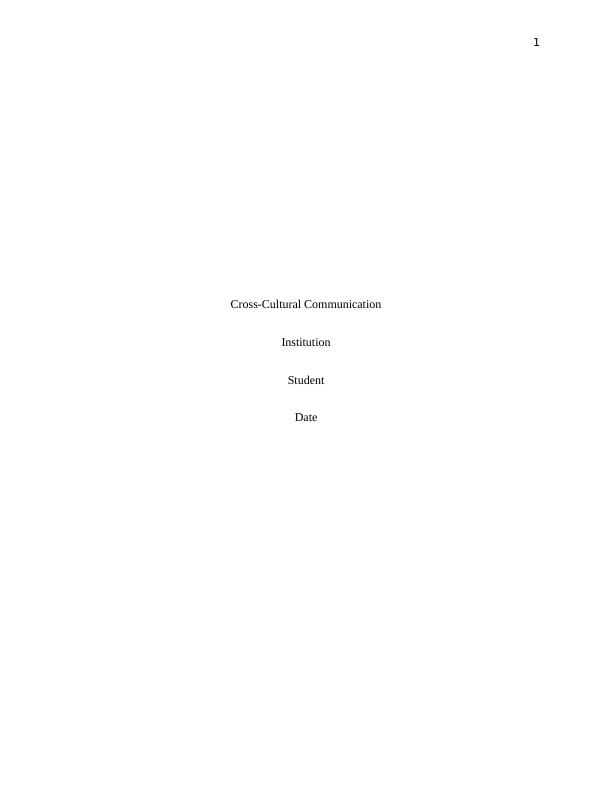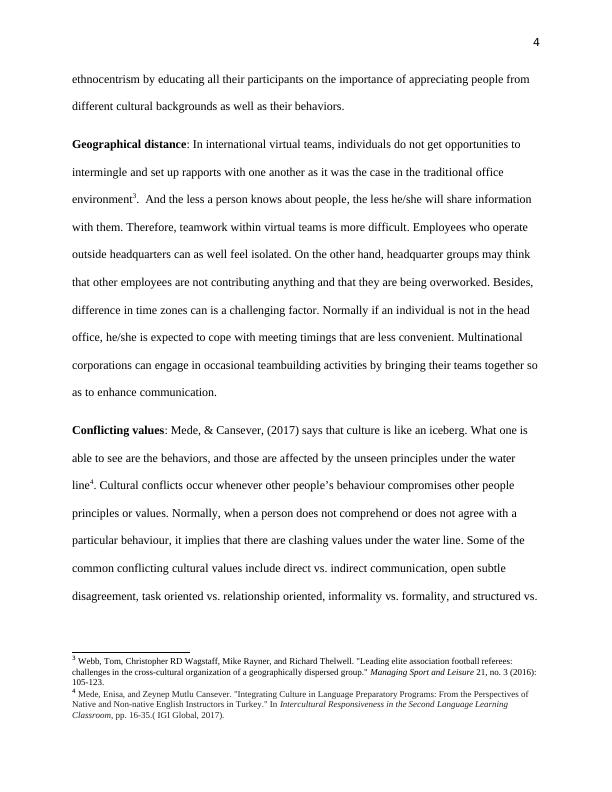Barriers to Cross-Cultural Communication and How to Overcome Them
Added on 2023-01-17
13 Pages3269 Words22 Views
1
Cross-Cultural Communication
Institution
Student
Date
Cross-Cultural Communication
Institution
Student
Date

2
Cross-Cultural Communication
Introduction to Cross-Cultural Communication
Cross-cultural communication has become advantageously vital to business organizations owing
to the growth and development of the Internet, technology, and global business. Understanding
cross-cultural communication is very imperative for all corporations which have a diverse labor
force or plans of going global. This form of communication encompasses an understanding of
the way people from dissimilar cultures perceive the world around them, communicate, and
speak. Cross-cultural communication in a given firm deals with comprehending different
communication strategies, beliefs, and business customs. In the global business arena, cross-
cultural communication assumes an important role in effectively conducting business with
stakeholders and teams in other areas of the globe. When the communication is effective,
everybody benefits from institutional knowledge, competitive advantage, and increased
bandwidth.
What are the barriers to effective cross-cultural communication? How might these be
surmounted?
There are various barriers which hinder the effectiveness of cross-cultural effectiveness. They
include language barriers, cultural barriers, ethnocentrism, geographical distance, conflicting
values, and presentation styles.
Language barriers: language is among the commonest cross cultural barriers in business
communication. Whilst English is considered as the ordinary global language of business, it is
worth noting that not all businesses globally use English on a regular basis. Workers might have
more difficulties when communicating in English language something which may contribute to
Cross-Cultural Communication
Introduction to Cross-Cultural Communication
Cross-cultural communication has become advantageously vital to business organizations owing
to the growth and development of the Internet, technology, and global business. Understanding
cross-cultural communication is very imperative for all corporations which have a diverse labor
force or plans of going global. This form of communication encompasses an understanding of
the way people from dissimilar cultures perceive the world around them, communicate, and
speak. Cross-cultural communication in a given firm deals with comprehending different
communication strategies, beliefs, and business customs. In the global business arena, cross-
cultural communication assumes an important role in effectively conducting business with
stakeholders and teams in other areas of the globe. When the communication is effective,
everybody benefits from institutional knowledge, competitive advantage, and increased
bandwidth.
What are the barriers to effective cross-cultural communication? How might these be
surmounted?
There are various barriers which hinder the effectiveness of cross-cultural effectiveness. They
include language barriers, cultural barriers, ethnocentrism, geographical distance, conflicting
values, and presentation styles.
Language barriers: language is among the commonest cross cultural barriers in business
communication. Whilst English is considered as the ordinary global language of business, it is
worth noting that not all businesses globally use English on a regular basis. Workers might have
more difficulties when communicating in English language something which may contribute to

3
misinterpretation of information whenever taking directions, understanding urgency levels and
communicating concerns or issues1. This barrier can be surmounted by adopting a mutual
language to be used by every participant in a global organizational setting.
Cultural barriers: Different cultures have different accepted behavior and decorum, business
ethics, sets of values, − even different gestures and facial expressions. When communicating
with professionals from other cultures, it is vital to comprehend these differences since it is a
show of authentic respect for other cultural conventions. For instance, in the US it is common for
a communicator to share personal stories to build a rapport with the audience, but in other
regions of the world this is perceived as a tedious practice. Humor may be particularly difficult
to incorporate; better to be straightforward instead of running the risk that the joke might
unintentionally humiliate or offense the listeners1. Cultural barriers can be surmounted by
initiating training programs to create aware on how to cope with cultural disparities which exist
among people from diverse cultural backgrounds.
Ethnocentrism: Every culture has a natural propensity to view other cultures through their own
lenses. Ethnocentrism takes place whenever people from a certain culture believe that their ways
of doing and seeing things are the correct and only ways. Therefore, they disapprovingly judge
behaviors that do not match their world visions. They perceive other culture’s behaviors as out of
the ordinary and inappropriate. Also, ethnocentrism leads to “us versus them” attitude that can be
harmful2. Organizations operating at the international scale can overcome the challenge of
1 Rosenthal, Bill. "Barriers to Cross-Cultural Business Communication." Communispond. June 29, 2016.
https://communispond.com/insights/blog/2016/06/29/82/barriers-to-cross-cultural-business-communication/ (accessed April 12,
2019).
2 Lai, Wen-Hsiang, and Ching-Wen Yang. "Barriers Expatriates Encounter During Cross-Cultural Interactions." Journal of
enterprising culture 25, no. 03 (2017): 239-261.
misinterpretation of information whenever taking directions, understanding urgency levels and
communicating concerns or issues1. This barrier can be surmounted by adopting a mutual
language to be used by every participant in a global organizational setting.
Cultural barriers: Different cultures have different accepted behavior and decorum, business
ethics, sets of values, − even different gestures and facial expressions. When communicating
with professionals from other cultures, it is vital to comprehend these differences since it is a
show of authentic respect for other cultural conventions. For instance, in the US it is common for
a communicator to share personal stories to build a rapport with the audience, but in other
regions of the world this is perceived as a tedious practice. Humor may be particularly difficult
to incorporate; better to be straightforward instead of running the risk that the joke might
unintentionally humiliate or offense the listeners1. Cultural barriers can be surmounted by
initiating training programs to create aware on how to cope with cultural disparities which exist
among people from diverse cultural backgrounds.
Ethnocentrism: Every culture has a natural propensity to view other cultures through their own
lenses. Ethnocentrism takes place whenever people from a certain culture believe that their ways
of doing and seeing things are the correct and only ways. Therefore, they disapprovingly judge
behaviors that do not match their world visions. They perceive other culture’s behaviors as out of
the ordinary and inappropriate. Also, ethnocentrism leads to “us versus them” attitude that can be
harmful2. Organizations operating at the international scale can overcome the challenge of
1 Rosenthal, Bill. "Barriers to Cross-Cultural Business Communication." Communispond. June 29, 2016.
https://communispond.com/insights/blog/2016/06/29/82/barriers-to-cross-cultural-business-communication/ (accessed April 12,
2019).
2 Lai, Wen-Hsiang, and Ching-Wen Yang. "Barriers Expatriates Encounter During Cross-Cultural Interactions." Journal of
enterprising culture 25, no. 03 (2017): 239-261.

4
ethnocentrism by educating all their participants on the importance of appreciating people from
different cultural backgrounds as well as their behaviors.
Geographical distance: In international virtual teams, individuals do not get opportunities to
intermingle and set up rapports with one another as it was the case in the traditional office
environment3. And the less a person knows about people, the less he/she will share information
with them. Therefore, teamwork within virtual teams is more difficult. Employees who operate
outside headquarters can as well feel isolated. On the other hand, headquarter groups may think
that other employees are not contributing anything and that they are being overworked. Besides,
difference in time zones can is a challenging factor. Normally if an individual is not in the head
office, he/she is expected to cope with meeting timings that are less convenient. Multinational
corporations can engage in occasional teambuilding activities by bringing their teams together so
as to enhance communication.
Conflicting values: Mede, & Cansever, (2017) says that culture is like an iceberg. What one is
able to see are the behaviors, and those are affected by the unseen principles under the water
line4. Cultural conflicts occur whenever other people’s behaviour compromises other people
principles or values. Normally, when a person does not comprehend or does not agree with a
particular behaviour, it implies that there are clashing values under the water line. Some of the
common conflicting cultural values include direct vs. indirect communication, open subtle
disagreement, task oriented vs. relationship oriented, informality vs. formality, and structured vs.
3 Webb, Tom, Christopher RD Wagstaff, Mike Rayner, and Richard Thelwell. "Leading elite association football referees:
challenges in the cross-cultural organization of a geographically dispersed group." Managing Sport and Leisure 21, no. 3 (2016):
105-123.
4 Mede, Enisa, and Zeynep Mutlu Cansever. "Integrating Culture in Language Preparatory Programs: From the Perspectives of
Native and Non-native English Instructors in Turkey." In Intercultural Responsiveness in the Second Language Learning
Classroom, pp. 16-35.( IGI Global, 2017).
ethnocentrism by educating all their participants on the importance of appreciating people from
different cultural backgrounds as well as their behaviors.
Geographical distance: In international virtual teams, individuals do not get opportunities to
intermingle and set up rapports with one another as it was the case in the traditional office
environment3. And the less a person knows about people, the less he/she will share information
with them. Therefore, teamwork within virtual teams is more difficult. Employees who operate
outside headquarters can as well feel isolated. On the other hand, headquarter groups may think
that other employees are not contributing anything and that they are being overworked. Besides,
difference in time zones can is a challenging factor. Normally if an individual is not in the head
office, he/she is expected to cope with meeting timings that are less convenient. Multinational
corporations can engage in occasional teambuilding activities by bringing their teams together so
as to enhance communication.
Conflicting values: Mede, & Cansever, (2017) says that culture is like an iceberg. What one is
able to see are the behaviors, and those are affected by the unseen principles under the water
line4. Cultural conflicts occur whenever other people’s behaviour compromises other people
principles or values. Normally, when a person does not comprehend or does not agree with a
particular behaviour, it implies that there are clashing values under the water line. Some of the
common conflicting cultural values include direct vs. indirect communication, open subtle
disagreement, task oriented vs. relationship oriented, informality vs. formality, and structured vs.
3 Webb, Tom, Christopher RD Wagstaff, Mike Rayner, and Richard Thelwell. "Leading elite association football referees:
challenges in the cross-cultural organization of a geographically dispersed group." Managing Sport and Leisure 21, no. 3 (2016):
105-123.
4 Mede, Enisa, and Zeynep Mutlu Cansever. "Integrating Culture in Language Preparatory Programs: From the Perspectives of
Native and Non-native English Instructors in Turkey." In Intercultural Responsiveness in the Second Language Learning
Classroom, pp. 16-35.( IGI Global, 2017).

End of preview
Want to access all the pages? Upload your documents or become a member.
Related Documents
Barriers to Intercultural Communication and Ways to Overcome Themlg...
|7
|1445
|321
Cross Cultural Communication - Documentlg...
|9
|2006
|12
Cross-Cultural Communication: Barriers, Ways to Overcome, Theories, and Importance in International Businesslg...
|8
|1687
|435
Problems of Ethnocentric Viewpoint in Intercultural Communicationlg...
|5
|1363
|460
Relationship between Language and Culture in Business Communicationlg...
|7
|1517
|31
Developing Cross-Cultural Capability for International Business Expansion - Deskliblg...
|20
|1322
|252